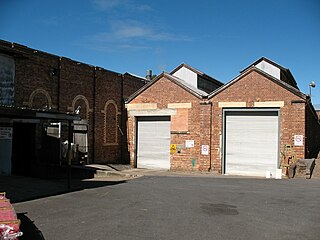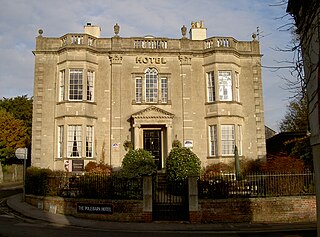This article needs additional citations for verification .(May 2019) |

Trowbridge Museum, in the town of Trowbridge, Wiltshire, England, is a centre for the history of West of England cloth production.
This article needs additional citations for verification .(May 2019) |

Trowbridge Museum, in the town of Trowbridge, Wiltshire, England, is a centre for the history of West of England cloth production.
The museum began as one small room in the Town Hall until it moved to the purpose-built Garlick Room in the Civic Hall in 1974. It remained there until July 1990, when the developers of The Shires Shopping Centre allowed it to take over the first floor of the Home Mills building.
The museum closed to the public in June 2018 and reopened in May 2021 after renovation and expansion to include a second floor, doubling its size, and the addition of a lift to improve access. [1] These works were made possible by £1.1m in funding from the National Lottery Heritage Fund, £900,000 from Trowbridge Town Council, and funds from The Friends of Trowbridge Museum and many members of the public. [2]
The 2012 exhibition Rare Machinery [3] presented the story of woollen cloth production in Trowbridge from its domestic beginnings through to the mechanisation of the process. As well as a complete Spinning Jenny – one of only five examples left in the world – the museum's displays included a fulling machine patented by Trowbridge engineer, John Dyer, in 1833. [4] It was such a technically accomplished design that the machine remained unchanged and was still in use in the 20th century. A fine teazle gig, which was used to raise the nap of the cloth, was also on display. The machine contains numerous "handles" of teazles (this was the name for the frames into which the teazles were fixed) which were dried out in the Handle House which can be found near the town bridge and Blind House, and is almost as rare as the Spinning Jenny.
As of 2021, the museum has around 25,000 items in its collections. [1] One of the staff's favourites is Joanna Turner's pocket watch, in silver and tortoiseshell, engraved inside with her name and the whole of the Lord's Prayer and Alexander Pope's Universal Prayer. She was a local evangelist in the 18th century. [5]
The Museum organises a bi-annual Textile and Weaving Festival which highlights the town's woollen cloth related architecture and the work of contemporary local textile artists.

Worsted is a high-quality type of wool yarn, the fabric made from this yarn, and a yarn weight category. The name derives from Worstead, a village in the English county of Norfolk. That village, together with North Walsham and Aylsham, formed a manufacturing centre for yarn and cloth in the 12th century, when pasture enclosure and liming rendered the East Anglian soil too rich for the older agrarian sheep breeds. In the same period, many weavers from the County of Flanders moved to Norfolk. "Worsted" yarns/fabrics are distinct from woollens : the former is considered stronger, finer, smoother, and harder than the latter.

In textile production, carding is a mechanical process that disentangles, cleans and intermixes fibres to produce a continuous web or sliver suitable for subsequent processing. This is achieved by passing the fibres between differentially moving surfaces covered with "card clothing", a firm flexible material embedded with metal pins. It breaks up locks and unorganised clumps of fibre and then aligns the individual fibres to be parallel with each other. In preparing wool fibre for spinning, carding is the step that comes after teasing.

Trowbridge is the county town of Wiltshire, England; situated on the River Biss in the west of the county, close to the border with Somerset. The town lies 8 miles (13 km) south-east of Bath, 31 miles (50 km) south-west of Swindon and 20 miles (32 km) south-east of Bristol. The parish had a population of 37,169 in 2021.

The spinning jenny is a multi-spindle spinning frame, and was one of the key developments in the industrialisation of textile manufacturing during the early Industrial Revolution. It was invented in 1764–1765 by James Hargreaves in Stan hill, Oswaldtwistle, Lancashire in England.
Thomas Helliker, known as the Trowbridge Martyr, was a figure in early English trade union history who was hanged, aged 19, for his alleged role in machine-breaking at a Wiltshire woollen mill. His conviction has been challenged as controversial and faulty, and he is now regarded as a victim of anti-Luddite sentiment.

The spinning mule is a machine used to spin cotton and other fibres. They were used extensively from the late 18th to the early 20th century in the mills of Lancashire and elsewhere. Mules were worked in pairs by a minder, with the help of two boys: the little piecer and the big or side piecer. The carriage carried up to 1,320 spindles and could be 150 feet (46 m) long, and would move forward and back a distance of 5 feet (1.5 m) four times a minute.

The Leeds Industrial Museum at Armley Mills is a museum of industrial heritage located in Armley, near Leeds, in West Yorkshire, Northern England. The museum includes collections of textile machinery, railway equipment and heavy engineering amongst others.

The National Wool Museum, located in Drefach Felindre, Llandysul, Carmarthenshire, is part of Amgueddfa Cymru – Museum Wales.

Helmshore Mills are two mills built on the River Ogden in Helmshore, Lancashire. Higher Mill was built in 1796 for William Turner, and Whitaker's Mill was built in the 1820s by the Turner family. In their early life they alternated between working wool and cotton. By 1920 they were working shoddy as condensor mule mills; and equipment has been preserved and is still used. The mills closed in 1967 and they were taken over by the Higher Mills Trust, whose trustees included historian and author Chris Aspin and politician Dr Rhodes Boyson, who maintained it as a museum. The mills are said to the most original and best-preserved examples of both cotton spinning and woollen fulling left in the country that are still operational.
The Wiltshire and Swindon History Centre in Chippenham, Wiltshire, England, serves as a focal point for heritage services relating to Wiltshire and Swindon. The centre opened in 2007 and is funded by Wiltshire Council and Swindon Borough Council. It has purpose-built archive storage and research facilities and incorporates the local studies library, museums service, archaeology service, Wiltshire buildings record and the conservation service.

George Haden (1788–1856) was a British engineer, inventor and holder of several patents relating to woollen milling and warm-air heating. He is most known for the design of heating systems for Wilton House, the Houses of Parliament, the British Museum Reading Room and in 1826, at the request of King George IV, Windsor Castle.

The Shires Shopping Centre is the central, covered shopping centre in Trowbridge, Wiltshire, England. The centre incorporates the county town's main museum and has a 1,000-space car park. As of 2009, approximately 120,000 shoppers visited the centre each week.

Queen Street Mill is a former weaving mill in Harle Syke, a suburb to the north-east of Burnley, Lancashire, that is a Grade I listed building. It now operates as a museum and cafe. Currently open for public tours between April and November. Over winter the café is opened on Wednesdays. It is also viewable with private bookings.

The Museum of Textiles and Industry is one of the two museums in Busto Arsizio, Italy, that specialises in spinning and weaving. It was opened in 1997 to house objects, pictures and archive material representing Busto Arsizio's industrial history.

Coldharbour Mill, near the village of Uffculme in Devon, England, is one of the oldest woollen textile mills in the world, having been in continuous production since 1797. The mill was one of a number owned by Fox Brothers, and is designated by English Heritage as a Grade II* listed building.

Queensland Woollen Manufacturing Company mill is a heritage-listed mill at 42 & 42B The Terrace, North Ipswich, City of Ipswich, Queensland, Australia. It is also known as Australian Fabric Manufacturers Ltd and Boral Hancock Plywood. It was added to the Queensland Heritage Register on 19 September 2008.

The Campolmi Factory, the Prato Textile museum and Lazzerini Library is a textile museum and library in Prato in Tuscany, Italy. The museum is an Anchor point on the European Route of Industrial Heritage.

The Polebarn Hotel in Trowbridge, Wiltshire is a building of historical significance and is Grade II* listed on the Historic England Register. It was built in 1789 by John Clark, a local textile mill owner and clergyman. It passed through successive generations of the Clark family until it was sold by auction in about 1920 to Wiltshire County Council, who used it firstly for Children's Services and later as flats. The house became a hotel in 1978.

The woollen industry in Wales was at times the country's most important industry, though it often struggled to compete with the better-funded woollen mills in the north of England, and almost disappeared during the 20th century. There is continued demand for quality Welsh woollen products.

Parade House is a Grade I listed Georgian townhouse in central Trowbridge, Wiltshire, England. It is a centrepiece of what Pevsner's Guide to Wiltshire described in 1960 as "a stretch of palaces" along Fore Street. Built in around 1720 for the wealthy cloth merchant Robert Houlton, Parade House has an elegant and symmetrical façade typical of the Georgian period. It was home to a succession of merchants during the 19th century at a time when Trowbridge was flourishing as a wealthy market town, until becoming the headquarters of Usher's Wiltshire Brewery for most of the 20th century. Today the building is a venue for public and private events.